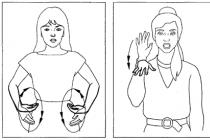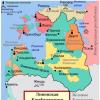People usually don’t think about how the payment that a person receives for his work is regulated and standardized. At best, people understand that there is a salary and a bonus. But it's not that simple. Salary consists of many parts, sometimes very different from each other. Let's figure it out. Let's start with the fact that it is recommended for every enterprise to have a provision on remuneration. This is a document that describes all the nuances of the process of forming the amounts that employees receive in their hands. This happens in every production with its own subtleties. In principle, everything is described in other documents, the main one of which is the Labor Code of the Russian Federation. The wage regulations collect the conditions in one text for the convenience of the employer and workers. It consists of several sections with different meanings.
General provisions
The first thing that is indicated in the document is the legislative acts on the basis of which it was drawn up. Any provision on remuneration is based on the Labor Code of the Russian Federation; its norms should not contradict the provisions of the latter. In addition, there are a number of by-laws that regulate the basic principles of the formation of salaries, bonuses, and so on, depending on the employee’s field of activity. So, for example, in enterprises with hazardous conditions, some standards apply, in places with special climatic conditions - others. The general part must indicate who specifically the norms of the document apply to and who is responsible for its implementation. That is, it is necessary to enter the position of the employee who will calculate wages and monitor compliance with legislation in this area. Naturally, these duties must be included in his instructions. The terms and procedure for payments are also indicated here. These are, so to speak, the obligations of the employer.
Wage
This section is directly devoted to describing the procedure for generating payments. All parts of the salary are specifically spelled out here: salary, allowances, bonuses, and so on. In addition, all types of bonuses provided under certain conditions are explained in detail. For example, the wage regulations of an LLC may include a list of norms and requirements related to production participants. If working conditions at an enterprise are different, then they should be broken down for each group of workers separately. At the same time, all the nuances are described in as much detail as possible. In addition, this section should contain information on the procedure for calculating payments in cases where the conditions for fulfilling duties deviate for one reason or another from the standard ones.

Bonuses
This is the favorite section of all employees. It specifies the conditions and forms of bonuses. One company believes that this payment should be fixed, another - as a percentage of... (the body may also be different). All conditions are specifically and in detail described in this section. It is important to pay some attention to the issues of the circle of employees who may qualify for a bonus, the conditions necessary for the implementation of this payment. It happens that an enterprise adopts a complex reward system; it needs to be deciphered in this section or a link to another document regulating this process must be made. The standard provision contains information on the terms, amounts and conditions of bonuses. It is important to indicate the conditions under which this payment is not made. In principle, the main function of this document is to clearly and in detail convey to the employee the rules of payment. Therefore, all points must be formulated in an accessible and unambiguous manner.
Other conditions
This is the most free section of the provision. It includes conditions that were not taken into account in the previous ones. These most often include social norms in special cases. For example, a wage regulation may contain information on the procedure for payments to women going on maternity leave, employees wishing to receive parental leave, and more. Many enterprises describe in this section special payments for workers retiring. These may be special bonuses for those who have worked in this organization for a long time. It is advisable to stipulate here what benefits an employee may have in the event of the loss of a breadwinner and other rare situations in life.

Final provisions
This section includes very specific conditions: when the provisions of the document begin to apply, who is responsible for its storage. This often describes where exactly the position will be kept, especially if the organization is large, with a huge management team. It is important in this section to include information about the order in which the document can be changed or supplemented, the procedure for agreeing on these changes with the team or trade union organization, and more. In addition, it is advisable to include in the provision a methodology for familiarizing employees with its contents and those responsible for this type of work (usually either a lawyer or a personnel officer).
Statement
Often this point is forgotten by those who write the regulations. However, its norms come into force only after the document is signed by the head or approved by his order. At enterprises where a trade union organization has been created, it is advisable to coordinate the situation with its representative body. When the formalities have been completed, it is necessary to familiarize all those for whom it was created, that is, employees, with its contents. This can be done at a general meeting to save time. But written confirmation that workers know what is written in it is mandatory. For example, you can create a special familiarization log or statement in which each employee will put the date of familiarization and personal signature.

Why does an employer need a position?
From the administration’s point of view, the document primarily acts as a regulator and indicator of wage amounts (for tax authorities). It must indicate
minimum wage corresponding to existing standards. In addition, the provision helps to influence unscrupulous employees, stimulating their activity through “carrot and stick” measures. Since it spells out all the incentive measures and conditions of punishment, they can be applied without fear, without fear of litigation. It is for this reason that mandatory written confirmation of the employee’s familiarization with the document is required in order to avoid unfounded claims.

Usefulness for the opposite side of the relationship
By understanding the meaning and methodology of wage formation, anyone can control the employer. It is no secret that production often “forgets” to give bonuses to those who, for some reason, are disliked by management.

Often this does not relate to the level and quality of performance of duties. So, any employee can appeal to the points of the document in order not to submit to the arbitrariness of management. That is, for the worker, this document acts as a kind of guarantor against unreasonable demands or nagging from the boss. In addition, from its contents it becomes clear which official to contact in specific cases. This makes the payroll mechanism transparent and clear for the worker, simple and logical for the administration. In the event of litigation related to wages, he can act as a regulator of relations.
Is it regulated somewhere who should develop and approve the Regulations on the remuneration of employees of a federal state budgetary institution?
Answer
Answer to the question:
In accordance with Part 4 of Article 135 of the Labor Code of the Russian Federation, local regulations establishing remuneration systems are adopted by the employer taking into account the opinion of the representative body of employees.
When developing the Regulations on remuneration in a federal budgetary institution, one must be guided by the Unified Recommendations for the establishment at the federal, regional and local levels of remuneration systems for employees of state and municipal institutions for 2017 (approved by the decision of the Russian Tripartite Commission for the Regulation of Social and Labor Relations dated December 23. 2016, protocol N 11).
Thus, the federal state budgetary institution develops regulations on remuneration independently.
When developing regulations, one must be guided by the approximate regulations on remuneration approved for federal institutions in a certain industry. .
Labor legislation does not establish mandatory approval of the Regulations on remuneration with the founder of a budgetary institution. Meanwhile, such coordination may be provided for in the constituent documents of the institution
Details in the materials of the Personnel System:
Situation: How to draw up a Regulation on the remuneration of employees
Ivan Shklovets, Deputy Head of the Federal Service for Labor and Employment
Consolidation of the remuneration system
Each organization independently determines which one to apply to its employees. In this case, the selected payment system can be specified in a separate internal document of the organization, for example. This follows from Part 2 of Article 135 of the Labor Code of the Russian Federation.
If an organization or individual entrepreneur that belongs to enters into a contract with employees, then from 2017 they can, including the Regulations on remuneration. However, all the conditions and guarantees provided for in the Regulations on Remuneration are necessary.
If a micro-enterprise loses its status, then within four months the employer will have to bring labor relations to. This must be done no later than four months from the date when changes were made to the unified register of small and medium-sized businesses.
This follows from articles 309.1 and 309.2 of the Labor Code of the Russian Federation.
Registration of the Payment Regulations
Labor legislation does not establish a standard form for the Regulation on Remuneration, so an organization can draw it up taking into account the specifics of its activities.
As a rule, the Regulations include the following sections:
- general provisions;
- the remuneration system used in the organization;
- provisions on additional payments and allowances due to employees;
- employee bonus procedures;
- procedure for payment and indexation of employee salaries.
Coordination of the Regulations on remuneration
After the work has been compiled, agree on it with the representative body of employees, for example, if there is one in the organization. This is stated in Part 2 of Article 135 of the Labor Code of the Russian Federation.
After agreement with the representative body, the Regulations should be approved by the head of the organization and its text should be familiarized with the employees of the organization against signature (Part 3 of Article 68 of the Labor Code of the Russian Federation). To do this, you can, in particular, keep a sheet for employees to familiarize themselves with the Regulations, where employees will put their signatures.
With respect and wishes for comfortable work, Tatyana Kozlova,
HR System expert
Regulations on remuneration- local regulatory act approved by the head of the organization. The main purpose of this document is to describe the payment and payment mechanisms used in the organization. Very often, this provision specifies not only the rules for calculating and paying wages, but also the bonus systems used in the organization (although the rules on bonuses can be included in a separate provision).
Important! It should be noted that, as such, the provision on remuneration is not mandatory: most of its norms are already included either in the internal labor regulations, or in, or in, and are also directly established in the Labor Code of the Russian Federation. Actually the regulation on remuneration in the organization is of an informational nature, since it combines the instructions of all the given sources and combines the rules of remuneration applied in the organization. In addition, the provisions on remuneration (and, first of all, its provisions on bonuses) are of great importance for tax purposes, because is documentary evidence of the justification of labor costs incurred by the organization.
There are no clear rules regarding whether it is necessary to combine the remuneration clause in one document with the bonus clause. Each organization that draws up the regulations on remuneration and regulations on bonuses acts in this matter at its own discretion. Current labor legislation does not contain any requirements for wage regulations. An analysis of Chapters 20 and 21 of the Labor Code of the Russian Federation suggests that it is advisable to include the following main issues in the regulations on remuneration:
- general requirements for the employee necessary for calculating his wages. The regulations may establish both general requirements for all employees and special requirements depending on the category of employee (requirements for qualifications, experience, etc.);
- wage system (time-based, piece-rate, piece-rate);
- minimum salary in the organization;
- salary amounts for certain categories of employees of the organization depending on the position held and (or) labor functions performed and (or) tariff rates, if the employee’s salary will be determined at such rates;
- limits on payment of wages in kind;
- procedure, place and timing of payment of wages;
- cases of deductions from wages, as well as restrictions on the amount of such deductions;
- rules of remuneration depending on the specifics of the organization:
- in special conditions (workers engaged in heavy work, work with harmful, dangerous and other special working conditions, in areas with special climatic conditions);
- in other cases of performing work under conditions deviating from normal;
- when performing work of various qualifications; - when combining professions and performing the duties of a temporarily absent employee; - outside normal working hours;
- on weekends and non-working holidays;
- at night time; - in case of failure to comply with labor standards (job duties);
- in the manufacture of products that turned out to be defective;
- when idle; - when developing new industries (products);
- labor standards, if they are directly related to the amounts of wages paid.
A special place in the wage regulations should be occupied by the rules for bonuses for employees.
IN Article 144 of the Labor Code of the Russian Federation it is stated that the employer has the right to establish various systems of bonuses, incentive payments and allowances, taking into account the opinion of the representative body of employees. It is necessary to indicate which ones are installed types of bonuses that an employee of this organization can count on. The bonus can be paid based on the results of a month, quarter, year, or based on the results of any specific work - completion of a particular project, etc.
It is necessary to clearly describe under what conditions (if what requirements are met) an employee can count on receiving bonuses, as well as what inverse indicators are established - bonus deduction indicators, i.e. lists of conditions under which the amount of an employee’s bonus may be reduced.
In the Regulations on remuneration it is necessary to develop remuneration amounts. The amount of the premium can be set V fixed size or V percentage of salary.
It also needs to be clearly stated what specific employees and upon reaching what indicators can count on one or another type and size of bonus.
Registered bonus payment terms.
Since there are no mandatory requirements for the development of Regulations on remuneration and bonuses, we can recommend the creation of a single document, since this will, first of all, ensure the consistency of this document, its systematicity and consistency in regulating wage relations in the organization.
Before approval of the Regulations by the head of the organization, this local document must be agreed upon with officials directly related to remuneration (for example, chief accountant, chief economist), as well as a representative of the legal department for compliance with the requirements of the legislation of the Russian Federation.
Structure of the Remuneration Regulations
Let us give an approximate structure of the Regulations on remuneration, which includes the following sections:
1. Terms and definitions.
This section specifies terms and definitions related to remuneration and bonuses for employees used in these Regulations
2. General provisions.
This section contains the following information: - basic acts (laws, by-laws, local acts of the organization) that regulate issues of remuneration in the organization;
- the person responsible in the organization for calculating the employee’s wages;
- the person responsible in the organization for resolving issues regarding bonus payments to employees;
- employees of the organization who are subject to this Regulation on remuneration;
- terms of payment of wages;
- rules and terms for providing a pay slip to an employee
3. Employees' wages.
Here are the following:
- requirements for the employee necessary for calculating his wages;
- labor standards, if they are directly related to the amounts of wages paid;
- wage system for certain categories of workers;
- wages for certain categories of workers;
- procedure, place and deadline for payment of wages.
4. Rules for remuneration in conditions deviating from normal ones.
This section specifies what additional payments are made and in what amount:
- when performing work of various qualifications;
- when combining professions and performing the duties of a temporarily absent employee;
- when expanding service areas or increasing the volume of work;
- outside normal working hours;
- for work on weekends and non-working holidays;
- for working at night,
as well as remuneration of employees for:
- failure to comply with labor standards;
- when idle.
5. Bonus payments to employees for key performance results.
This section specifies:
- types of awards;
- bonus indicators;
- remuneration amounts;
- the circle of employees who can count on monetary incentives;
- timing of bonus payments.
If the organization uses various differentiated bonuses, then all incentives can be placed in separate sections while maintaining the section containing the general rules on bonuses. Regulations for various types of bonuses and incentives can also be developed, which will be appendices to this Regulation.
6. Employer's liability.
In this section it is necessary to indicate what liability the employer bears in case of delay in payment of wages and other violations of wages.
7. Other conditions of remuneration.
This section describes other remuneration issues. They can regulate the issues of entry into force of the provision, amendments to it, the person responsible for storing this provision, etc.
Additional sections may be added to the Regulations if necessary.
The current labor legislation does not oblige employers to develop and approve a separate local regulatory act that regulates exclusively the issues of remuneration of employees. The corresponding norms can be enshrined in a collective agreement (a legal act regulating social and labor relations in an organization and concluded by employees and the employer represented by their representatives).
In recent years, the development and approval of wage regulations has become widespread in the public sector, as well as in some natural monopolies with full or predominant state participation. In this case, the scope of the provisions extends to the entire industry or to the entire group of interrelated organizations.
At the same time, regulations on remuneration can also be developed at the level of an individual business entity (employer - legal entity or individual entrepreneur).
The purpose of developing and approving a separate regulation on remuneration may be to determine the forms and systems of remuneration, establish a system of criteria for calculating wages in an increased amount, and ultimately - to strengthen the material interest of workers in the quantity and quality of work.
The regulations on remuneration are developed on the basis of the requirements of labor legislation, as well as regulations at the industry and departmental level adopted in its development. In this case, the norms of the industry tariff agreement, collective agreements and agreements in force in the organization are taken into account.
If an organization simultaneously has a collective agreement and regulations on wages, certain norms can be reproduced in both local regulations, but should not contradict each other.
From this we can conclude that when developing and approving wage regulations, the same rules and restrictions that are established by labor legislation for the conclusion of collective labor agreements must be observed. Thus, the regulation is developed and approved by the administration of the business entity, but the process of approving the regulation must include a procedure for taking into account the opinion of the representative body of workers (remember that since October 2006, such a body does not have to be a trade union organization).
Let us recall that certain articles of the Labor Code of the Russian Federation provide for the mandatory registration of the representative body of workers in the following cases (only links are provided to articles whose norms may be included in the regulations on remuneration):
- - when approving the list of positions for workers with irregular working hours (Article 101 of the Labor Code of the Russian Federation);
- - when drawing up shift schedules (103);
- - when adopting local regulations establishing remuneration systems (135);
- - when approving the form of the pay slip (136);
- - when establishing specific amounts of increasing wages for workers engaged in heavy work, work with harmful and (or) dangerous and other special working conditions (147);
- - when establishing specific amounts of payment for work on a weekend or non-working holiday (153);
- - when establishing specific wages for night work (154);
- - when establishing labor standardization systems (159);
- - when adopting local regulations providing for the introduction, replacement and revision of labor standards (162);
- - when approving the internal labor regulations of the organization (190).
The regulation on remuneration is a local regulatory act. Therefore, when adopting it, the requirements established by labor legislation for local regulations must be observed.
In particular, the adoption of local regulations containing labor law standards must be provided for by a collective agreement or agreements.
Local regulations that worsen the situation of workers in comparison with labor legislation, collective agreements, agreements, or adopted without observing the procedure for taking into account the opinions of the representative body of workers provided for by the Labor Code of the Russian Federation are invalid. In such cases, laws or other regulatory legal acts containing labor law standards are applied (Article 8 of the Labor Code of the Russian Federation).
Local regulations of an organization containing labor law norms are valid within the boundaries of this organization (Article 13 of the Labor Code of the Russian Federation).
From the norms of individual articles of the Labor Code of the Russian Federation, we can conclude that the provisions on remuneration as a local normative act may reflect the following questions (the article of the Labor Code of the Russian Federation containing a reference to the local normative act is indicated in brackets):
- - duration of daily work or shift (94);
- - a list of jobs whose duration during the day and night is equalized (when necessary due to working conditions, as well as for shift work with a six-day work week with one day off) (96);
- - the procedure for dividing the working day into parts (105);
- - the amount and procedure for paying additional remuneration for work on non-working holidays to salaried employees (112);
- - the procedure and conditions for providing additional (except for those provided for by law) leaves for employees (116);
- - the procedure for indexing wages in connection with rising consumer prices for goods and services (134);
- - wage systems, tariff rates, salaries, various types of payments (135);
- - tariff systems of remuneration (143);
- - wage systems in state and municipal institutions (144);
- - periods for calculating average wages that differ from the periods established by law, provided that this does not worsen the situation of employees (139);
- - additional payments made to employees when performing work in working conditions that deviate from normal (when performing work of various qualifications, combining professions, work outside the normal working hours, at night, on weekends and non-working holidays, etc.) (149);
- - specific amounts of payment for overtime work (152);
- - specific amounts of payment for work on a weekend or non-working holiday (153);
- - specific amounts of increasing pay for night work (154);
- - introduction, replacement and revision of labor standards (162);
- - procedure and amount of reimbursement of expenses related to business trips (168);
- - the amount and procedure for reimbursement of expenses associated with business trips of employees whose permanent work is carried out on the road or has a traveling nature (168.1);
- - reduced production standards for workers under the age of eighteen (270);
- - the procedure for paying for rest days in connection with work on a rotational basis outside the normal working hours within the accounting period (301);
- - the amount and procedure for paying bonuses for shift work (302);
- - additional guarantees and compensation for persons working in the Far North and equivalent areas (in addition to those established by the laws of the constituent entities of the Russian Federation) (313);
- - working and rest conditions of workers sent to work in representative offices of the Russian Federation abroad (339).
When implementing practical measures to develop a Regulation on remuneration, not only the composition of the indicators included in the regulation (elements of remuneration), but also the structure of the document is of significant importance.
Taking into account the above, the approximate structure of the Regulations may be as follows.
1. General Provisions
In this section it is advisable to list:
- - legislative and regulatory acts on the basis of which the Regulations were developed;
- - forms and systems of remuneration in force in the organization, as well as indicate the categories of employees for whose remuneration they are applied;
- - forms and conditions of payments (frequency, terms and place of payment of wages, the possibility of paying for labor in kind, etc.);
- - a system of allowances, additional payments, compensation and incentive payments applicable to the payment of labor for certain categories of workers (without a detailed explanation of the conditions and payment mechanism);
- - the basics of labor regulation - the establishment and revision of labor standards.
- 2. Basic salary of employees
In this section, you should indicate the elements of remuneration, grouped by employee categories - organization management, engineering personnel, technical personnel, production workers, maintenance personnel, etc.
It is advisable to separately reflect the following elements:
- - system of official salaries for management employees, engineering and maintenance personnel;
- - conditions for salary increases and maximum increases;
- - a system of hourly tariff rates for time workers of various qualifications, a system of piece rates for piece workers;
- - conditions and procedure for increasing salaries for work in hazardous working conditions and in other cases when labor legislation provides for increased payment. Let us remind you that an increase in salaries and tariff rates and rates does not apply to incentive or compensatory payments that are made in excess of salaries and rates, including increased ones.
- 3. Remuneration in conditions deviating from normal
In this section, it is advisable to list all additional payments and allowances applied in the organization when working in conditions different from normal - on weekends and holidays, at night, when working overtime, etc.
It is also advisable to group additional payments and allowances by categories of employees, as well as indicate the conditions for their payment (for example, when paying for work on weekends and holidays - within the normal working hours and in excess of the specified norm).
4. Remuneration for work performed by other employees
Here it is appropriate to resolve issues of part-time work (internal and external), temporary substitution, combination of professions and positions, expansion of service areas, etc.
A separate section may include a provision on bonuses for main performance results. Although in some cases (for example, when the conditions and amounts of bonuses for employees of certain categories differ significantly, and the number of categories of employees in the organization is very large), it may be more appropriate to develop and approve a separate local regulatory act - the Regulations on Bonuses.
In any case, the Bonus Regulations must reflect at least the following elements (bonus indicators):
- - size of premiums - from minimum to maximum;
- - the conditions under which bonuses are paid, as well as under which the size of the bonus may be reduced, or the bonus may not be paid at all;
- - frequency of bonus payment.
In the case where bonus indicators are different for different categories of employees, it is advisable to group them into separate subsections.
In addition, the Regulations on Remuneration may reflect the size, conditions and procedure for making payments made from the organization’s net profit - profit at the end of the year (reporting quarter), financial assistance.
The main difference between these payments and wages itself is that they are not accepted as expenses for tax purposes, and an additional condition for their payment is the availability of net profit.
In cases where the employees of an organization are simultaneously its shareholders or participants, in our opinion, it is advisable to include in the Regulations on Remuneration the procedure for paying dividends (the amount of income distributed among the participants of a limited liability company or production cooperative).
Shift schedules (Article 103 of the Labor Code of the Russian Federation) and the internal labor regulations of the organization (Article 190 of the Labor Code of the Russian Federation), although they are directly related to remuneration, in our opinion, there is no need to attach them to the Regulations on remuneration - the listed local regulations are mandatory annex to the collective agreement.
It is advisable to develop (revise) the wage regulations so that they come into force on January 1 of the new year. This will make it possible to take into account the provisions enshrined in this local regulatory act when developing (clarifying) the organization’s accounting policies for accounting and tax purposes. It follows from this that the Regulations on remuneration should be approved before the end of the year preceding the one from which it comes into force.
APPROVED:
By order of the director No. 157 dated 08/01/2016.
REGULATIONS ON WAGES
1. General Provisions
1.1. These Regulations have been developed in accordance with the current legislation of the Russian Federation and the Charter of the enterprise. It is being introduced with the aim of organizing a unified system of remuneration and bonuses for workers, increasing the material interest of workers in high work results, responsibility for the performance of job duties, implementing a coordinated policy in matters of remuneration within the enterprise, as well as for the purpose of social protection of workers.
1.2. This Regulation on remuneration is based on the requirements of the Labor Code of the Russian Federation.
1.3. The regulations on remuneration establish the procedure for paying and bonusing employees (paid and non-paid) taking into account the results of their work and the achieved results of financial and economic activities of both the enterprise as a whole and its structural divisions.
1.4. The wage regulations provide:
1.4.1. differentiation of wages for workers, taking into account the characteristics of each structural unit (workshop, service, department, etc.);
1.4.2. optimal ratio in remuneration of workers according to the complexity and responsibility of the work performed;
1.4.3. compliance of job titles and professions with a unified classification system;
1.4.4. creation of a bonus system that corresponds to the enterprise strategy, allowing to control and adequately evaluate the contribution of employees to the implementation of assigned tasks;
1.4.5. effective use of the enterprise's personnel potential;
1.4.6. compliance of bonus payments with the results of financial and economic activities.
2. Enterprise wage fund
2.1. The main areas of use of the wage fund are:
2.1.1. payment of the basic salary, in accordance with section 4, - remuneration of employees;
2.1.2. monthly bonus based on monthly work results;
2.1.3. payment of additional payments and incentive bonuses;
2.1.4. payment for next vacations.
2.2. The basic salary is a guaranteed monetary remuneration for the employee’s performance of the job duties assigned to him, his level of qualifications, specialization and is paid monthly in full.
3. Payroll planning
3.1. Payroll planning is carried out quarterly with a monthly breakdown. The planned wage fund includes payment according to tariffs and salaries of employees, bonuses, in accordance with the regulations on wages. Overspending of the planned wage fund is not allowed.
4. Remuneration of employees
4.1. Employees are remunerated from the wage fund.
4.2. This Regulation applies to employees who are in an employment relationship with the Company on the basis of concluded employment contracts both at their main place of work and those working part-time.
4.3. This Regulation establishes a system of remuneration for employees of the Enterprise, taking into account the specifics of the organization of labor and its payment in the Enterprise.
4.4. The terms of remuneration provided for by this provision are an integral part of the employment contract concluded by the enterprise with the employee. A change in the terms of remuneration established by this provision is a change in the previously agreed terms of the employment contract and can only be made by agreement of the parties to the employment contract or unilaterally at the initiative of the employer, subject to the conditions, procedure and time limits in accordance with the provisions of Art. 74. Labor Code of the Russian Federation.
4.5. The basis of wages are:
4.5.1. for the management staff - monthly salaries established by the staffing table and approved by the director, the amount of salaries increases in proportion to the change in tariff rates and salaries of employees engaged in production activities.
4.5.2. for workers - hourly tariff rates or salaries, calculated in accordance with the Unified Tariff Schedule, established by the staffing table and approved by the director of the enterprise.
4.6. The inter-grade grid (Appendix No. 1) was used in accordance with the Unified tariff schedule for wages, approved by Order of the Gosstroy of Russia dated March 31, 1999 No. 81.
4.7. The basis for differentiation of tariff rates and official salaries is the minimum monthly tariff rate of a worker of the first category of the main specialty when working under normal conditions, subject to full working hours.
4.8. Minimum monthly tariff rate:
4.8.1. for repair personnel - mechanic of the 1st category, it is set at 8114 rubles 00 kopecks;
4.8.2. for operational personnel - boiler room operator of the 1st category, the amount is set at 7056 rubles 00 kopecks.
4.9. At the end of each quarter, it is possible to index the minimum monthly tariff rate to the actual increase in consumer prices in the Russian Federation, subject to the availability of funds.
4.10. Worker categories are established by profession in accordance with the Unified Tariff and Qualification Directory of Work and Professions of Workers and the complexity of the work performed.
4.11. Remuneration for workers of motor transport is calculated in accordance with Appendix No. 2.
4.12. The procedure, conditions of remuneration and material incentives for the director of the enterprise, as well as the chief engineer, deputy director for economics and finance, and chief accountant are determined by employment contracts.
4.13. The Employer keeps records of the actual time worked by employees in an electronic time sheet.
4.14. Salaries are paid twice a month:
4.14.1. payment for the first half of the month (50% of the employee’s tariff rate (official salary)) – on the 25th of the billing month;
4.14.2. final payment is on the 10th day of the month following the settlement month.
4.15. The salary is transferred to the employee to the bank account in which the employee has this account.
4.16. If necessary, payment of wages to an employee can be made at the cash desk.
4.17. Deductions from an employee's salary are made only in cases provided for by the Labor Code of the Russian Federation and other federal laws, local regulations of the organization or at the request of the employee.
4.18. The employer makes deductions from wages in the following cases:
4.18.1. reimbursement of unearned advances issued to employees on account of wages;
4.18.2. repayment of unspent and not timely returned advance payment issued in connection with a business trip or transfer to another job in another locality;
4.18.3. return of amounts overpaid to the employee due to accounting errors or in the event that the body for the consideration of individual labor disputes recognizes the employee’s guilt in failure to comply with labor standards or downtime;
4.18.4. when an employee is dismissed before the end of the working year for which he has already received annual paid leave, for unworked vacation days;
4.18.5. deductions to pay off the employee’s obligations to the state (taxes, fines);
4.18.6. deductions to pay off debts to third parties (alimony for minor children, payments under writs of execution for compensation for harm to the health of another person or harm to persons who have suffered damage, etc.).
4.19. The total amount of all deductions for each payment of wages cannot exceed 20%, and in cases provided for by federal laws - 50% of wages due to the employee, except for deductions at the request of employees.
4.20. In some cases established by the legislation of the Russian Federation, the amount of deductions from wages cannot exceed 70%.
4.21. Deductions are not allowed from payments that are not subject to collection in accordance with federal laws.
4.22. Upon termination of the employment contract, payment of all amounts due to the employee from the Employer is made on the day the employee is dismissed. If the employee did not work on the day of dismissal, then the corresponding amounts are paid no later than the next day after the dismissed employee submits a request for payment. In the event of a dispute about the amount of amounts due to the employee upon dismissal, the employer is obliged to pay the undisputed amount within the period specified above.
4.23. Wages not received by the day of the employee’s death are issued to members of his family or to a person who was dependent on the deceased on the day of his death. Payment of wages is made no later than a week from the date of submission of the relevant documents to the Employer.
4.24. If an employee fails to fulfill official duties due to the fault of the Employer, payment is made for the time actually worked or work performed, but not lower than the average salary of the employee calculated for the same period of time or for work performed.
5. Remuneration of employees not on the payroll
5.1. To perform the necessary work and due to the lack of these specialists at the enterprise, contract agreements may be concluded with employees.
5.2. A contract for the performance of one-time work is concluded in a uniform form accepted by the enterprise.
5.3. The amount of remuneration under a contract is determined by agreement of the parties and may differ from the remuneration of payroll personnel.
5.4. The source of funds for remuneration of non-payroll employees is the enterprise's wage fund.
5.5. Upon completion of work under the contract, a certificate of acceptance and delivery of completed work is drawn up. Based on an act approved by the director of the enterprise and signed by the head of the department for which the work was performed, payment for the work under this contract is made.
6. Additional payments and allowances
The company has the following surcharge system:
6.1. Additional payment for combining a profession (position). (TCRF art. 151, TC clause 3. art. 255)
Additional payment for combining a profession (position) is made only if the staffing table provides for this profession (position) and it is vacant. Combination means that the employee performs, along with his main work stipulated by the employment contract, additional work in another profession (position). The period of absence of the replaced employee (manager, specialist, employee) must be at least 7 days.
6.2. Additional payment for performing the duties of an absent employee.
For performing, along with his work, the duties of a temporarily absent employee (vacation, illness, business trip, etc.) without being released from his main job, an additional payment is made for performing an additional amount of work at jobs that do not have a replacement provided for in the staffing table. The amount of additional payment is set to 50% of the tariff rate (salary) of the employee’s basic salary or the difference in salaries of the replaced employee and the replacement employee for the days actually worked.
The additional payment is established by order of the director of the enterprise.
Additional payments for the performance of duties of temporarily absent managers are not made to their full-time deputies.
Step replacement is not allowed.
6.3. Additional payment for work in harmful and (or) dangerous working conditions














